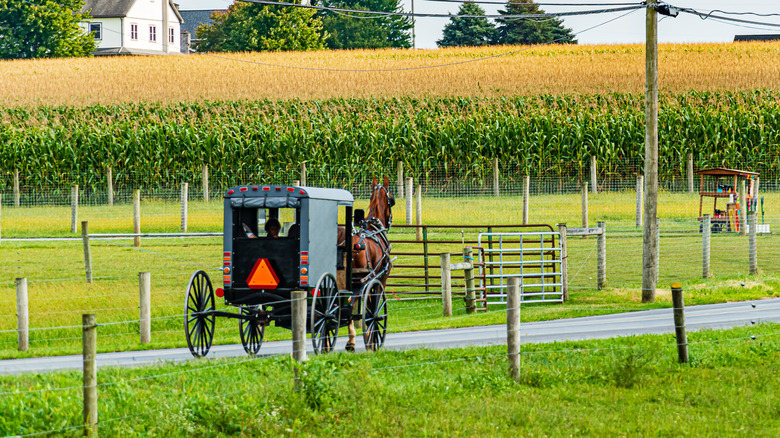What Makes The Amish Community's Soul Food Unique?
The Amish are one of the most well-known religious communities in the United States. Shunning advanced technologies and cities in favor of a rural life of simplicity, religious observance, and pragmatism, the Amish have been a fixture in American culture since they first arrived here in the 18th century. While other religious sects — like the Shakers — have dwindled to near extinction, the Amish continue to thrive as a culture and source of curiosity.
In spite of their tendency toward isolation, the Amish have managed to run highly successful businesses outside of their community. Outside entrepreneurs have taken notice of the fact that Amish businesses have a 95% success rate. Many of these businesses are bakeries and markets. Known for their simple and flavorful cakes, brownies, pies, preserves, and breads, the Amish have long since learned how to make a living selling the products of their kitchens and gardens. However, there is one iteration of Amish food that has only recently come to public attention.
We're all familiar with soul food. It's that beautiful cuisine born out of southern African American culture: peach cobbler, cornbread, gumbo, and the like. During the Great Migration, African Americans brought soul food out of the south and into the north. Those who settled in Chester County, Pennsylvania, found a kindred spirit in the cuisine of their new Amish neighbors. Over the course of generations, the cooking of Chester County evolved into what is now called Amish soul food.
What is Amish soul food?
Amish soul food is an amalgamation of generations worth of interactions between the African Americans of Chester County and the local Amish neighbors. Following the Reconstruction of the post-Civil War South, many African Americans moved to the industrialized north in search of better economic opportunities and living situations. They settled in and around the already highly urbanized areas of the region — including Philadelphia and nearby counties — and brought several aspects of their culture with them, not the least of which was the soul food recipes that suddenly found themselves in need of adaptation.
As luck would have it, Amish markets of Chester County were chock full of shared staple ingredients. Things like cornmeal and a pickled relish known as chow-chow were close at hand, along with other dishes and sides that naturally complemented some soul food classics. Cobblers and pies were adaptable desserts, and cornmeal could be used to make cornbread or pulverized into mush to serve alongside a savory stew.
The seven sweets and sours of classic Amish cooking — side dishes designed to create a more balanced diet — were also found to bring a unique flair to this new soul food. Vegetables and meats could get an added kick of vinegar, while sugar could amp up the sweetness of a fruit. Over time, and with much practice, these elements combined to develop a true fusion of American cuisines.
What makes Amish soul food unique?
Chris Scott is an award-winning chef who grew up in Coatesville, Pennsylvania in Chester County. He grew up with the heritage of Amish soul food — a term he coined himself — surrounding him on a daily basis. The interesting thing Scott points out is that while the food is certainly a true fusion of Amish food and soul food, the Amish themselves don't actually engage in eating any of it. Instead, Amish soul food became a way of honoring the evolving cuisine of Chester County African Americans while simultaneously honoring their neighbors' heritage.
In his development of the cuisine, Scott wanted to show that African American soul food could be more than what's been classically portrayed. A prime example he gives is the fact that for fried chicken, Southerners will brine the meat in sweet tea, while a practitioner of Amish soul food would do it in lemonade. Yet another example of the sour and sweet balance.
The backgrounds of both cultures also play a significant role in the uniqueness of the cuisine. The Amish fleeing persecution in Europe and the legacy of African American slavery actually created similar culinary practices. Both the enslaved and Amish kept gardens and needed to be resourceful with what little they had on hand. The shared foods, like stews, dumplings, cobblers, and pies, seemed to be on a destined track to one day meet one another. And meet they have, in the most delicious of ways.


